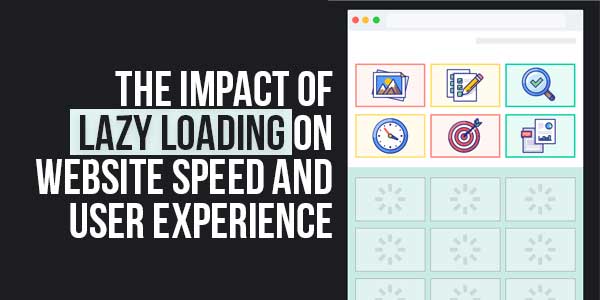
Lazy loading involves postponing the loading of images and other elements on a website page until they are actually required by the user. By utilizing this new-age technique, you can speed up the initial page load. It achieves this by initially loading only essential content and deferring the loading of less crucial elements such as images. This method boosts the user experience by initially prioritizing the content visible to users. Using this effective method, a business focuses on delivering its website’s core textual and interactive elements first.
Meanwhile, the images and other less-important components load progressively as the visitor scrolls. Consider incorporating lazy loading if your webpage contains numerous resources. However, apply it exclusively to the content below the visible area or outside the users’ immediate view. Also, you must never use lazy loading for any resources necessary for executing background tasks. You can utilize this technique for non-critical web resources rather than essential ones.
What could cause a web page to load slowly? It may be because of the page’s size, specifically the amount of content it contains and the file sizes of each element. Having numerous images, videos, and other media can slow down the page’s speed, leading frustrated visitors to leave. Luckily, there is a solution that doesn’t need you to reduce the content – lazy loading.
This new-age technique boosts website loading speed and reduces bandwidth usage. This blog offers readers a comprehensive understanding of lazy loading and its positive impact on website speed and user experience. Continue reading to gain further insights.
Table of Contents
Understanding The Concept Of Lazy Loading:
Lazy loading involves postponing the loading of images and other elements on a website page until they are actually required by the user. Instead of loading all the resources when the page is accessed, only the visible content above the fold is initially displayed. Images and other content further down the page are loaded dynamically as the user scrolls through them.
In websites without image lazy loading, when a user visits a page, the browser downloads all the assets and resources before rendering the page for the user to view. This can result in long loading times, especially if the page contains resources that take time to download and render.
It can frustrate users highly and may lead them to abandon the site, particularly if this occurs repeatedly for every link they click. However, with the implementation of lazy loading, the browser replaces images that are yet to be loaded with a temporary placeholder image.
Visitors may briefly see the placeholder as they scroll until the browser inserts the image in its intended position. This is a widely used technique by web design companies in NYC. It significantly improves the page load time and enhances user experience, particularly for sites with many images.
While lazy loading primarily applies to images, it can be equally beneficial for other assets and resources on a webpage.
The Top 5 Benefits Associated With Lazy Loading:
Faster Page Load:
You can speed up the initial page load using the lazy loading technique. It achieves this by initially loading only essential content and postponing the loading of less crucial elements such as images. As a result, a website tends to load faster, leading to increased user satisfaction, lower bounce rates, and greater user engagement.
Websites that load quickly can retain visitors, improve their experience and improve the likelihood of conversions.
Enhanced User Experience:
Lazy loading significantly improves the user experience by initially prioritizing the content visible to users. With this viable technique, a business focuses on delivering its website’s core textual and interactive elements first. Meanwhile, the images and other less-important components load progressively as the visitor scrolls.
Lazy loading ensures that visitors can swiftly access the desired information without waiting for all the images to load. Offering your users a seamless and interactive browsing experience can effectively keep them engaged and encourage them to explore your site further.
Minimized Bandwidth Usage:
By implementing lazy loading for your images, your website can efficiently deliver only the necessary assets to users. Consequently, the browser avoids wasting bandwidth by downloading images that won’t be visible to users. This significantly reduces bandwidth usage over time.
If your website contains numerous images with larger file sizes, this effective bandwidth management can produce substantial benefits right from the start. The bandwidth conservation is advantageous for both you and the users. By not serving unnecessary assets, you also ensure that your servers maintain low bandwidth usage.
Improved Mobile Performance:
The dominance of mobile browsing in the online realm emphasizes the importance of mobile optimization. A key element in boosting mobile performance is the implementation of lazy loading, which optimizes the usage of resources.
Given the limited processing power and smaller screens of mobile devices, loading every image concurrently can result in slower page rendering and a negative user experience. By incorporating this modern-day technique, mobile users can witness faster loading times, lesser data consumption, and a seamless browsing experience.
This is irrespective of the limitations of their devices. However, this can be difficult to carry out if you lack technical expertise. In that case, you can take the help of a custom website design firm in NYC.
Improved Search Engine Optimization (SEO) Outcomes:
Website speed is a critical factor considered by search engines when determining search rankings. Adopting lazy loading can significantly enhance your website’s loading times, positively impacting your SEO endeavors.
Websites that load faster tend to rank higher in search results, leading to increased organic traffic and visibility. Lazy loading aids search engine crawlers in navigating a website, ensuring that relevant content is indexed. It improves the chance of achieving better rankings for relevant search queries.

When Should You Use Lazy Loading?
Optimize The Loading Of Right Resources:
Consider incorporating lazy loading if your webpage contains numerous resources. But, you must apply lazy loading exclusively to the content below the visible area or outside the users’ immediate view.
Remember an important point in this context; never use lazy loading for any resources necessary for executing background tasks. Examples of such resources include JavaScript components, background images, etc. Also, refrain from delaying the loading of these resources.
To identify potential resources for implementing lazy loading, you can utilize the Lighthouse tool available in the Chrome browser.
Loading Non-Vital Website Resources:
You can perform lazy loading for non-critical web resources rather than essential ones. Additionally, remember to incorporate error-handling mechanisms and provide a smooth user experience in case the resource does not load as expected.
Also, remember that native lazy loading is not universally supported across all browsers and platforms. Furthermore, lazy loading won’t work for all users in the case of a library or a custom JavaScript implementation. This is particularly seen for JavaScript-disabled browsers.
Apply Lazy Loading To Content Non-Essential For SEO:
Implementing lazy loading causes your website to render gradually. This means some content is not immediately available during the initial page load. Many people believe that lazy loading increases page rank on search engines by enhancing page load speed. However, excessive use of lazy loading can have a negative impact.
During the process of SEO indexing, search engines crawl websites to gather data for indexing pages. However, owing to lazy loading, web crawlers cannot access all the page data unless a user interacts with the page.
Consequently, this information will be overlooked for SEO purposes. As a website owner, you wouldn’t want your crucial business data to be missed. Therefore, you must not use lazy loading for SEO-targeted content. This includes keywords and business information.
Final Thoughts:
Lazy loading is a proven way to improve page performance and keep visitors on your site. If you decide to go for lazy loading, test your site with this new feature prior to launching it. It is a smart technique for web designers and developers to improve the usability and performance of a webpage.
But, overusing this technique can reduce the site’s performance. You can work with a custom web design company in New York to get the best result.

 About the Author:
About the Author:
















Be the first to write a comment.